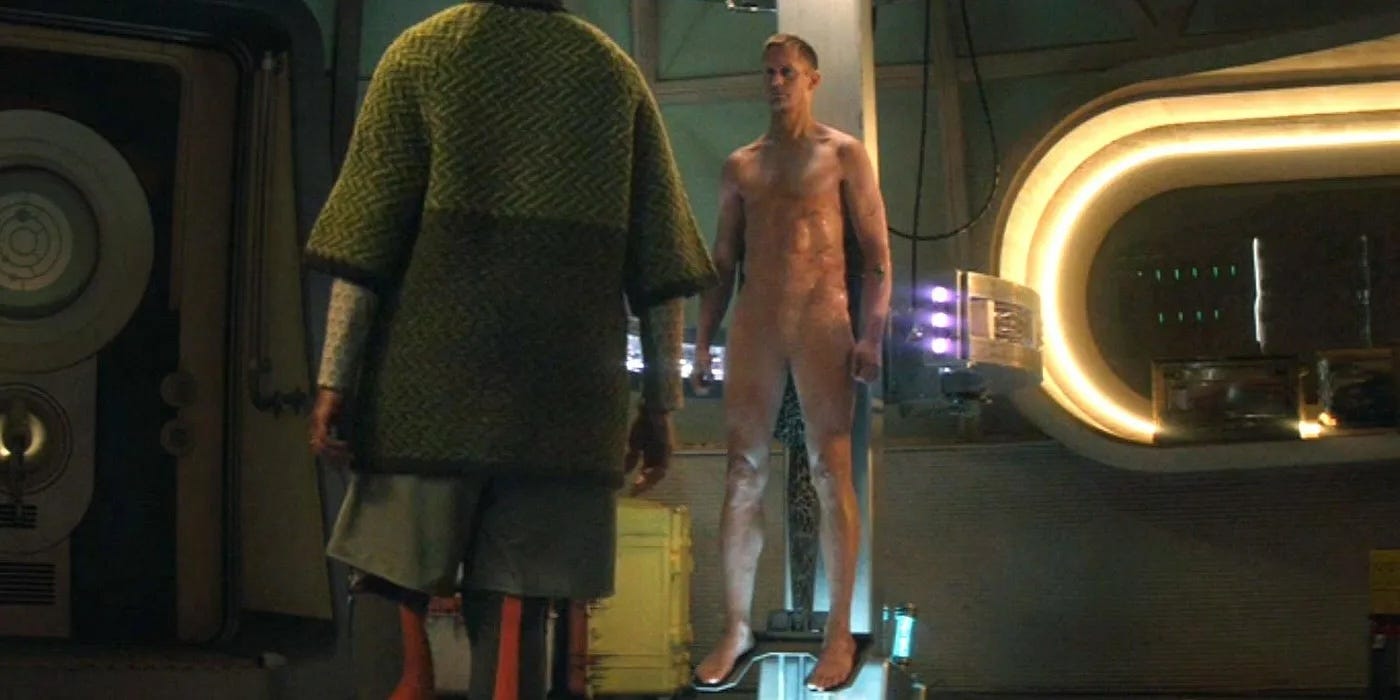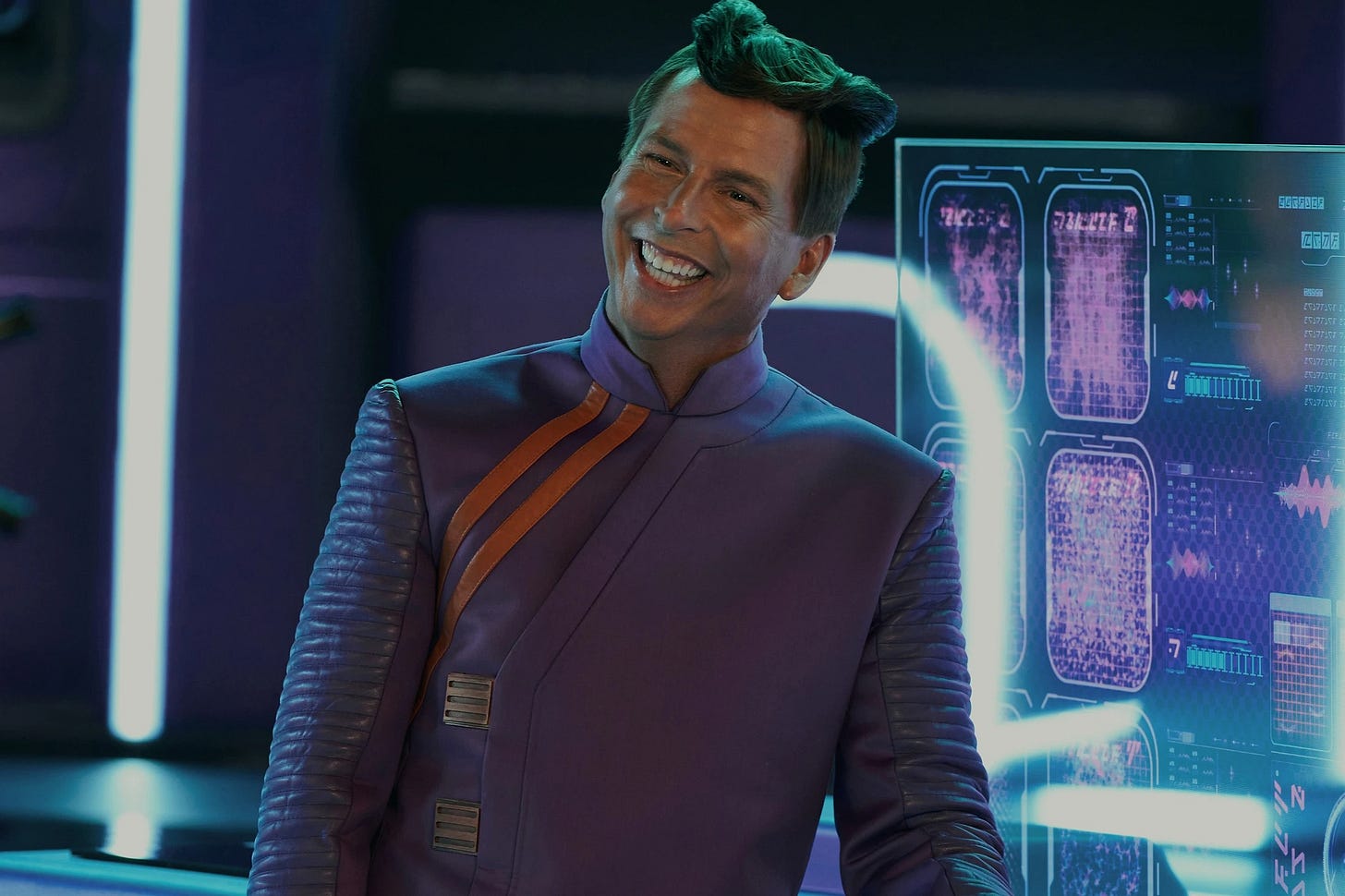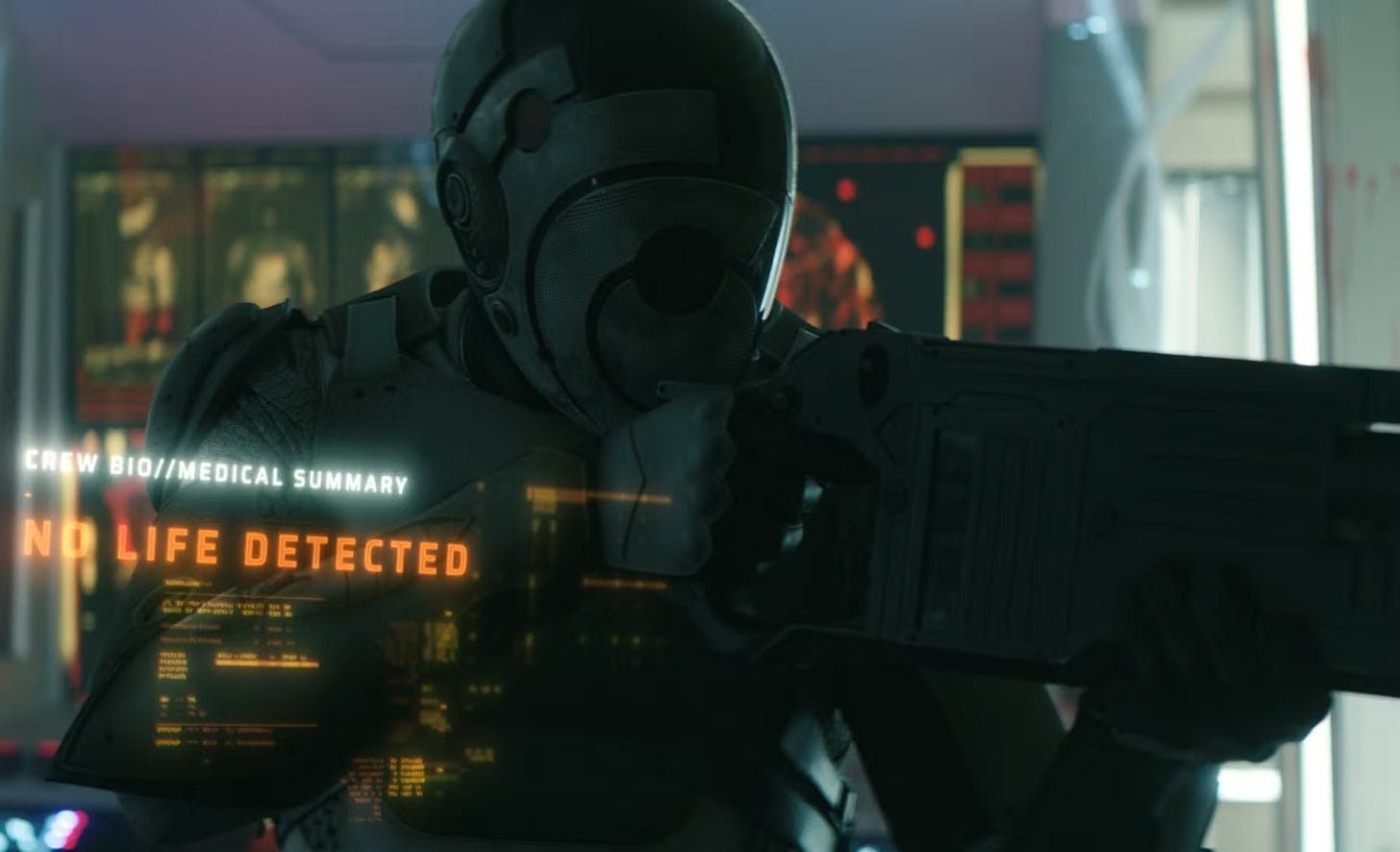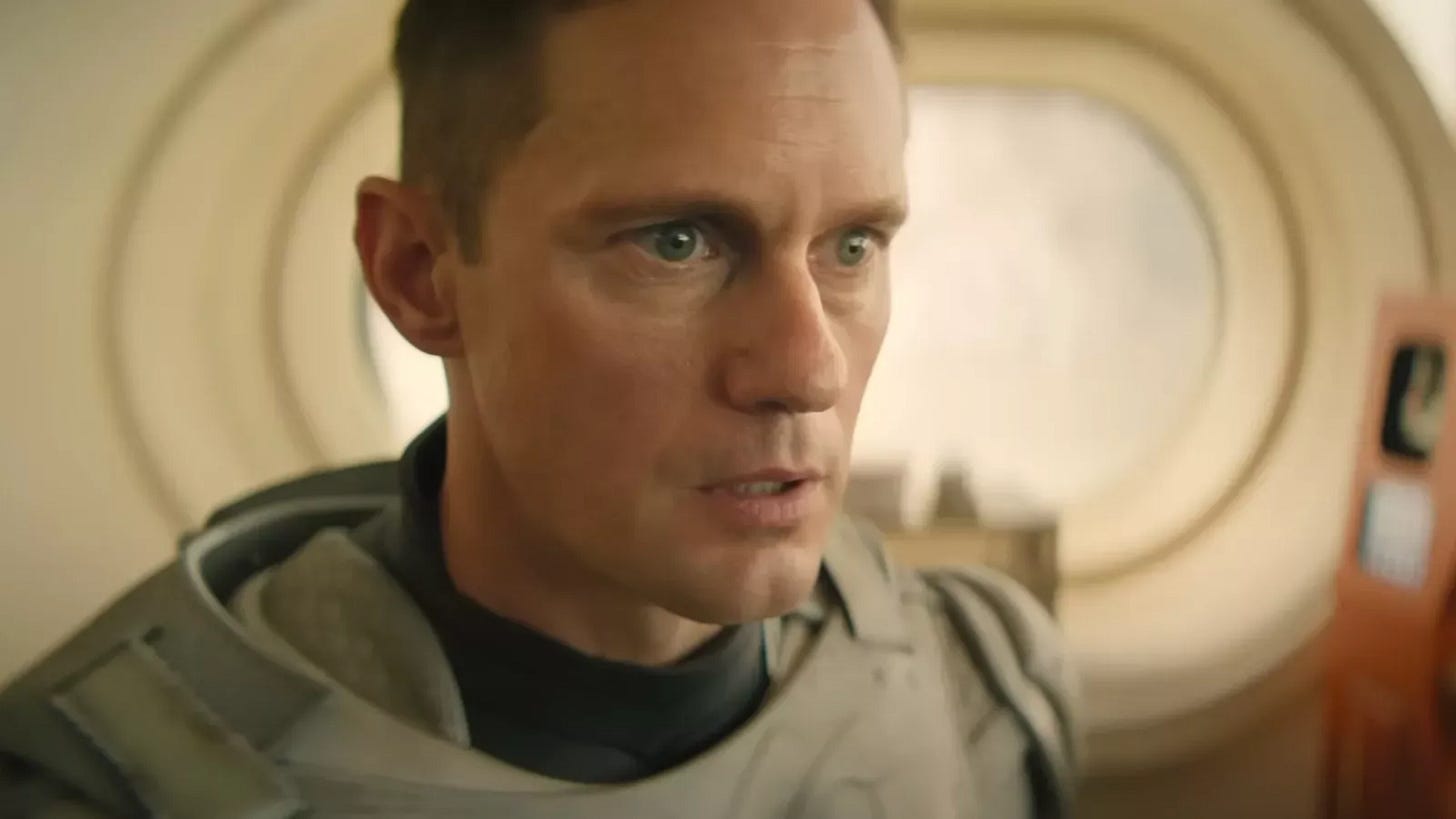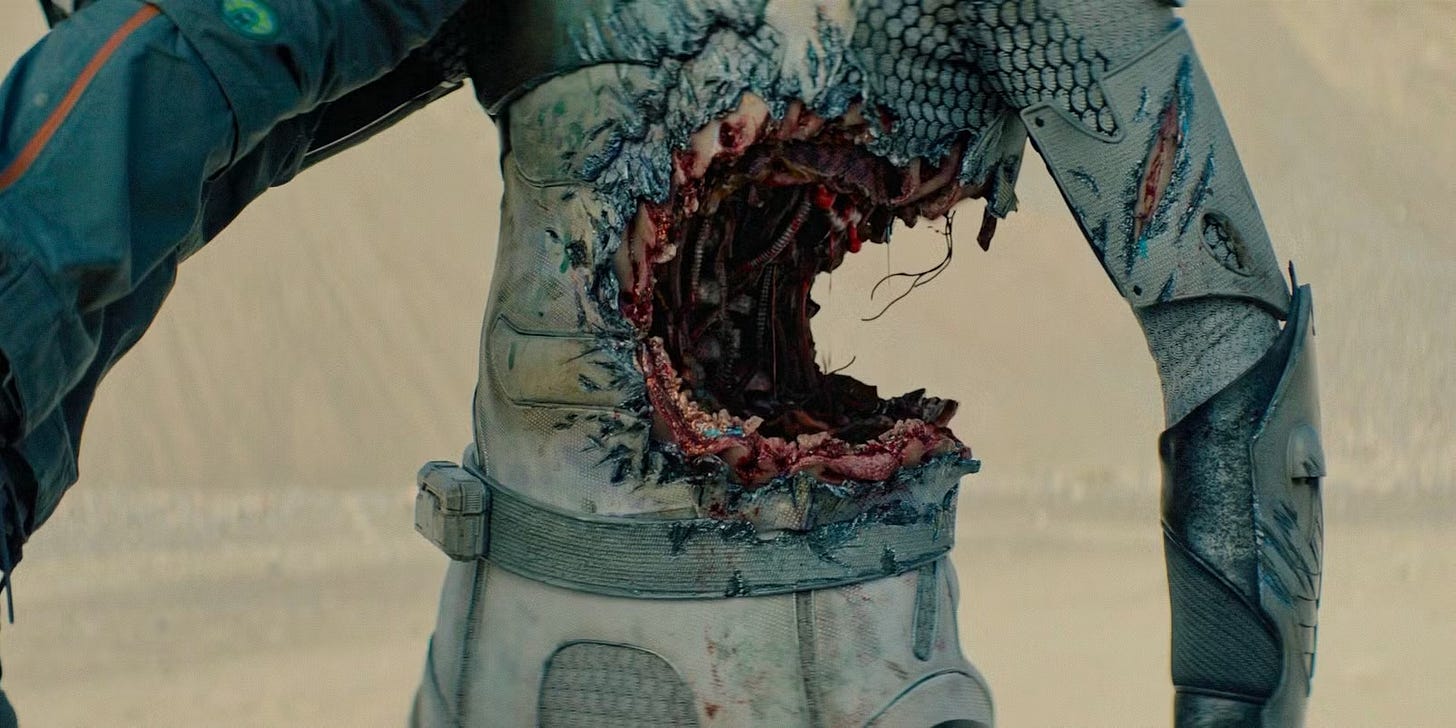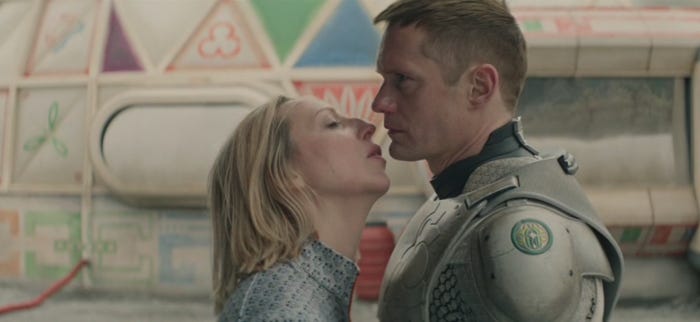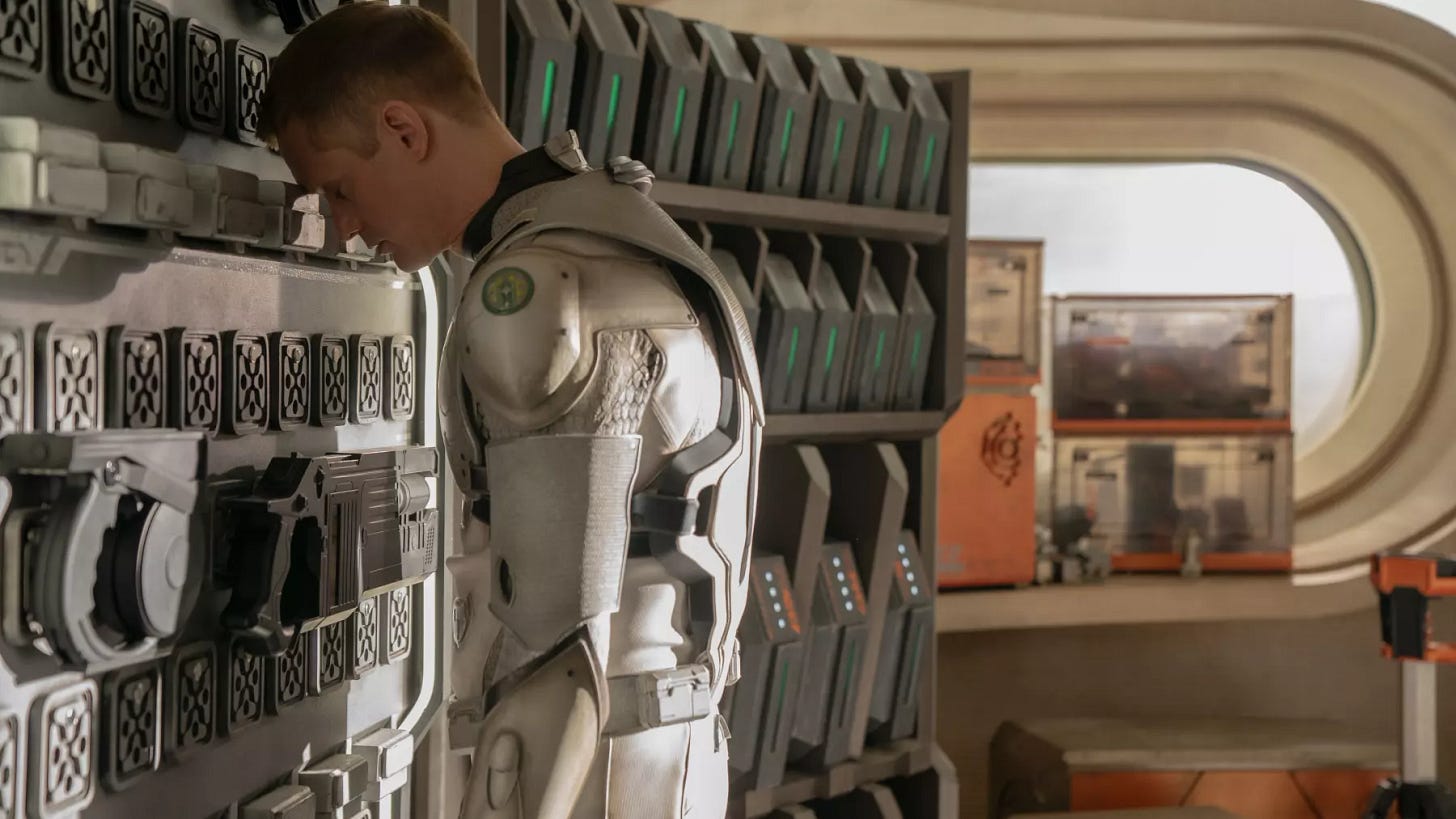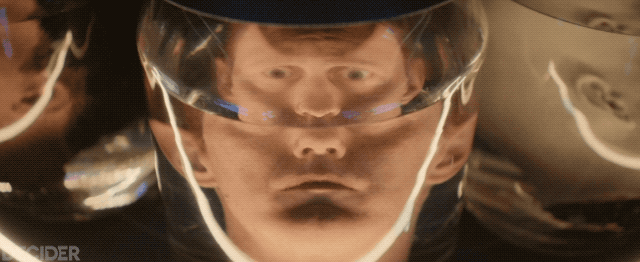I started watching Apple’s new series Murderbot when there were only three episodes — but having to wait an entire week for another 20 minute installment of a very engaging show is frustrating. So I decided to read the book the show is based on, All Systems Red by Martha Wells. And then her next one, and her next one… As we’re closing in on the final episode of the season, I’m getting ready to finish System Collapse, Martha Wells’ most recent installment in the Murderbot stories, having been unable to resist, upon completion of each book, quickly moving onto and binging the next. (Apple won’t let me binge the show, but I guess they can’t stop me from binging the books!) I want to recommend this series to you, lucky people who haven’t seen it yet — lucky, because you’ll be able to watch the whole thing without waiting.
The binge-watcher at the center of the story, the titular “Murderbot,” is a Security Unit (SecUnit) externally shaped like a man (minus any genitalia) who has guns in its arms and whose consciousness is formed within a combination of both cloned human tissue and high speed wireless digital interactivity. It was constructed by a company in a corporation-ruled universe as 1) a physical enforcer of security rules, 2) a disposable target for weapons fire, and 3) spyware.
The context is a maximally exploitative economic system in which a seemingly very high percentage of humans are also treated as property, contracted into “labor” agreements that can require they be shipped to other planets and star systems to work for others’ profits. The SecUnit at the center of the story, who re-names itself “Murderbot,” is an alarmingly relatable creation: abused, devalued, ignored, it has to continue to do its job, and because of how it was made, it’s a bundle of anxieties and paranoias, absolutely anhedonic (forget a penis, it doesn’t even have dopamine), and its suffering is only relieved by watching its shows.
As the story starts, the SecUnit figures out how to hack its own “Governor Module” (a pain-inducing punishment device that assures its compliance and will kill it if it does not conform), and, now free, fantasizes about killing all the humans that have been torturing it. But having attained free will, it also decides to opt for self-preservation: a mass-murdering rogue SecUnit would be destroyed. (A SecUnit isn’t the biggest or baddest violence-machine in this universe!) So instead, it just keeps doing its job, pretending that its Governor Module still works, which means obeying every order. Meanwhile, to ease its boredom and anxiety, it downloads thousands of hours of entertainment programming and starts binging serials, especially a space adventure called “The Rise and Fall of Sanctuary Moon” (with thousands of episodes on its own). The humans are divided about Sanctuary Moon: some think it’s fun, the rest think it’s trash.
The books give us very little to go on, but Apple’s Murderbot series provides generous helpings of a campy melodrama full of familiar faces.
Reading the books while watching the series has been a fun experience: the books offer some things the show can’t, and the show offers many things the books can’t. As an adaptation, the series is additive: it takes the material from the book and develops it. Yes it also cuts a few characters and changes the humans’ relationships with one another, but mostly it adds. What the books give us that the series can’t is that full immersion into Murderbot’s mind. The books are mainly first-person accounts from Murderbot’s point of view, and so information is limited to what Murderbot bothers to learn, and the books can be absolutely obsessive about the things that capture its attention, like threat assessments and risk assessments and the subtleties of the “feed” and the the pings and handshakes with other machines, and the experience of machine interaction. The novel Network Effect is virtually a non-stop action scene, and a lot of that action takes place in the digital ether. The show gives glimpses of this, and I’d say does it really well, too, but the books are grounded in that perspective.
Whether in the books or the show, Murderbot is both protective of its humans, and can’t fucking stand its humans. It’s frustrated by their stupidity, but it’s also painfully conscious of its own failings — paranoia and self-loathing would be its primary modes if it weren’t focused on something else, which is why it distracts itself with tv shows. The humans regard SecUnits as scary killing machines, but they are really more like surveillance and cyberdefense systems whose arms have built-in energy weapons, and whose bodies are considered reparable and/or disposable. More than anything what it reminds me of is, well, being a mom. There I said it: Murderbot is a mama duck. A mama duck trying to keep all its ducklings safe and alive. The ducklings are stupid and frustrating, and btw don’t you dare sexualize the mama duck because that’s not what’s going on here! And you know what kids, sometimes you just gotta go away and let mama watch her stories. But every time she gets 2 minutes into a show, there they go again. Always getting interrupted. Never any time just for her.
The actor who portrays Murderbot, Alexander Skarsgård, plays this part incredibly well. Murderbot is dangerous but also vulnerable. Hyper-aware but also terrified. Smart but also addicted to a kind of dumb tv show. The character is plaintively self-obsessed, as in neurotic, but is also unthinkingly self-sacrificial.
Murderbot isn’t like some other human-passing AIs in fiction: it’s no Commander Data, it doesn’t “admire humans” and “want to be more like them.” If Murderbot imitates humans it’s only to not get caught. In Star Trek TNG season one, “The Measure of a Man,” Data goes on trial to determine whether he’s a “person” or “property” — the story turns upon the revelation that Data had a sexual relationship with Tasha Yar when she was alive — almost to suggest that anything with a sex life must be a person! — and is capped by the antagonist going from referring to Data as “it” to calling him “him.”
Murderbot is an “it” and is repulsed by human sexual activity. It’s offended to be thought of as a sexbot, something the series has a lot of fun with when, for example, Leebeebee starts fantasizing about “adding features” like “push the balls to vibrate.” (That’s not in the books — neither is Leebeebee, and she’s a great addition!)
More to the point, in this universe, people often ARE property. This isn’t the utopian “Federation of Planets,” this is a dystopian “Corporation Rim.” The humans that Murderbot finds himself working for are from an outlying culture called Preservation Alliance, and they believe in human rights and dignity, but that just makes them laughably naive rubes to everyone else, who conquer or cower like dogs eating dogs (or getting eaten). In this universe, a construct like a SecUnit just takes the exploitative logic to its natural conclusion.
Dare I say that our world is too much like the Corporation Rim? And that our experience of life in the modern world is too much like Murderbot’s? Mineral mining and data mining. Contracts and leverage. Constant surveillance. Pockets of idealism that would die without violent but selfless action from people given no other choice but to “serve.” It’s all a little disturbingly familiar.
So the character is endlessly appealing and I really hope this series continues. There’s definitely enough material in the books for 10 seasons, especially if they keep developing it and adding more to the story-world. I’d love to see them *continue* adding nuance to the secondary characters, and *keep* devising these more complex complications and climaxes, because they are *exceptionally* good at it. I desperately hope they get far enough in the series to portray ART (Asshole Research Transport), an AI frenemy of Murderbot who could probably carry a series on its own.
I recommend the show, and again, I’m jealous if you get to watch the whole season without having to wait weeks between episodes, but I also recommend the books. Comparing them in your mind won’t confuse you so much as add layers to your conception of its world.





